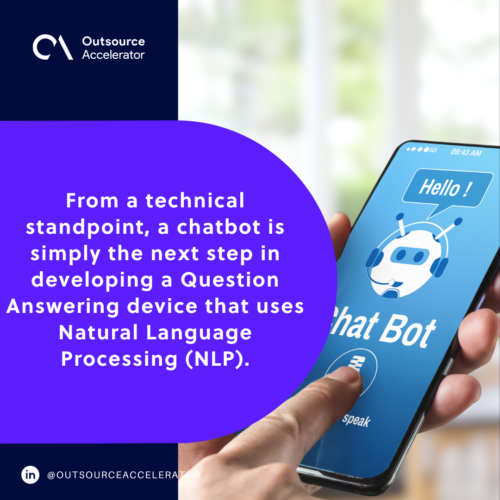Chat Bot
Definition
What is a chatbot?
A chatbot is a type of technology that mimics human conversations. Chatbots use the combination of artificial intelligence (AI), data science, and speech recognition to comprehend and react to the individuals they communicate with. Companies use chatbots to optimize both service and sales conversion.
The majority of chatbots are accessible through the internet via website popups or virtual assistants. Chatbot systems are designed to convincingly mimic how a person will act as a conversational partner.
They usually require continuous tuning and testing. Those in development are still unable to converse or pass the industry benchmark sufficiently.
Importance of chatbots in businesses
A chatbot is one of the most innovative and successful forms of human-machine communication. From a technical standpoint, a chatbot is simply the next step in developing a Question Answering device that uses Natural Language Processing (NLP).
Chatbots have various purposes such as customer support, request routing, and data collection. While some chatbot applications employ comprehensive word classification systems, natural language processors, and complex AI, others search for general keywords and produce responses based on popular phrases obtained from a related database.
Chatbots can be as essential as one-line programs that respond to a simple question or as advanced as digital assistants that learn and develop as they collect and process data to increase interactivity levels.
Chatbots improve operating performance and reduce costs for companies while also providing comfort and value-added services to internal staff and external customers. They allow businesses to quickly address a wide range of customer questions and issues while reducing the need for personal communication.

Types of chatbots
Chatbots today come in a variety of shapes and sizes, with different levels of capability. Chatbots have three common types; support chatbots, skills chatbots, and assistant chatbots.
Support chatbots
Support chatbots are designed to be experts in a specific area, such as company experience. Personality, multi-turn functionality, and context awareness are needed for support chatbots.
Support Chatbots also enable the customer to type their question into a message and receive an immediate solution. A mixture of Artificial Intelligence and rule-based Natural Language Understanding techniques may try to interpret and address the query automatically. Suppose the answer to a question necessitates the system asking a few issues first. In that case, it can engage in a brief discussion with the customer before searching the business backend system for the response.
Virtual assistant chatbots
The term virtual personal assistant chatbot refers to combining two separate programs: a chatbot and a virtual assistant.
Virtual assistant chatbots must be communicative and respond to almost everything while being as amusing as possible. Since the range of questions a consumer can ask is comprehensive, ensuring sufficient coverage will be the most challenging factor.
Skills chatbots
Skills chatbots are usually single-turn bots that do not need a great deal of contextual knowledge. For this form of a chatbot, speech capability is suggested not to turn on a screen or press any buttons.
People can quickly learn what to say and how to say it correctly, so these chatbots don’t need to worry about contextual knowledge unless you want to design a highly advanced one.







 Independent
Independent




